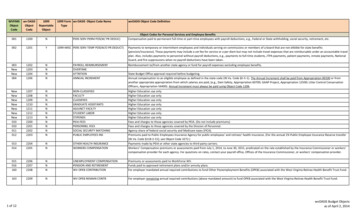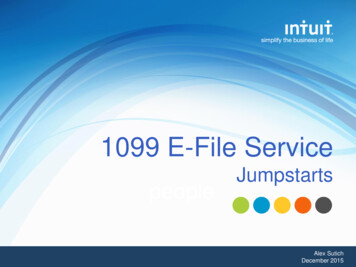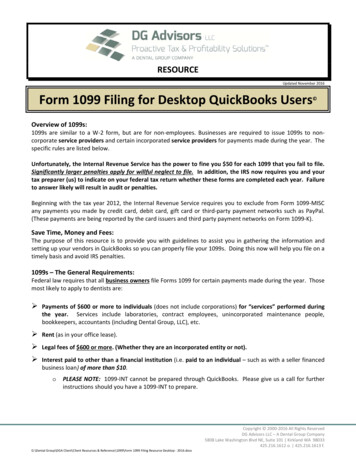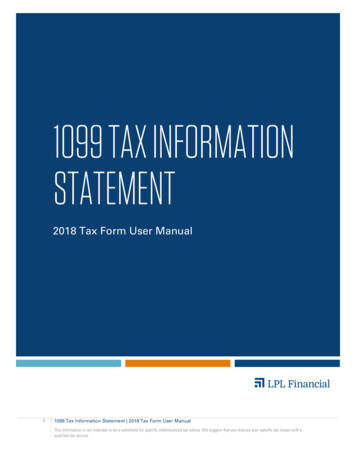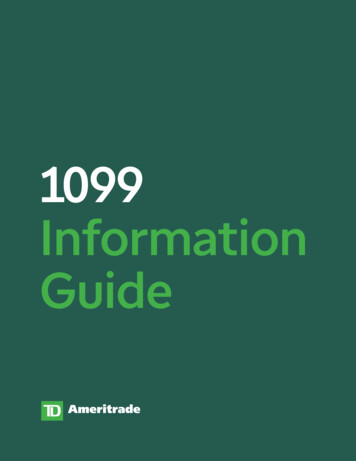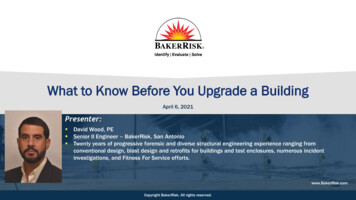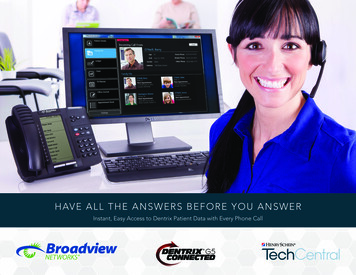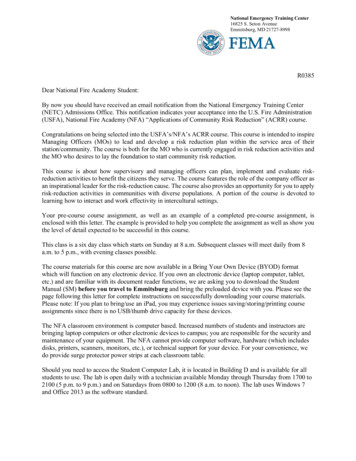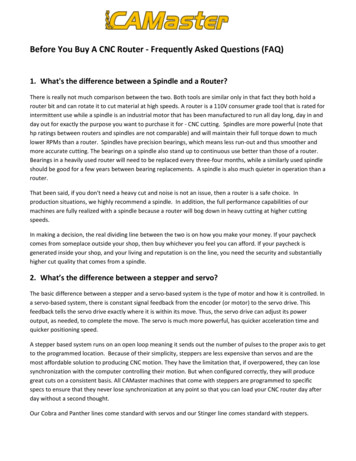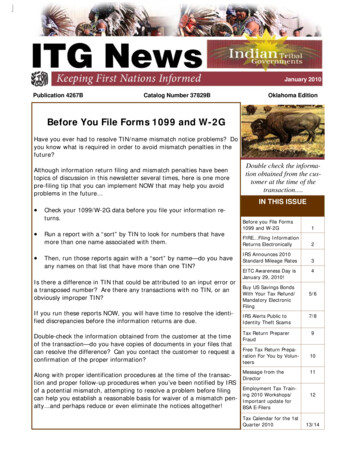
Transcription
January 2010Publication 4267BCatalog Number 37829BOklahoma EditionBefore You File Forms 1099 and W-2GHave you ever had to resolve TIN/name mismatch notice problems? Doyou know what is required in order to avoid mismatch penalties in thefuture?Although information return filing and mismatch penalties have beentopics of discussion in this newsletter several times, here is one morepre-filing tip that you can implement NOW that may help you avoidproblems in the future Double check the information obtained from the customer at the time of thetransaction .IN THIS ISSUE Check your 1099/W-2G data before you file your information returns.Run a report with a “sort” by TIN to look for numbers that havemore than one name associated with them.Then, run those reports again with a “sort” by name—do you haveany names on that list that have more than one TIN?Is there a difference in TIN that could be attributed to an input error ora transposed number? Are there any transactions with no TIN, or anobviously improper TIN?If you run these reports NOW, you will have time to resolve the identified discrepancies before the information returns are due.Before you File Forms1099 and W-2G1FIRE.Filing InformationReturns Electronically2IRS Announces 2010Standard Mileage Rates3EITC Awareness Day isJanuary 29, 2010!Buy US Savings BondsWith Your Tax Refund/Mandatory ElectronicFiling45/6IRS Alerts Public toIdentity Theft Scams7/8Double-check the information obtained from the customer at the timeof the transaction—do you have copies of documents in your files thatcan resolve the difference? Can you contact the customer to request aconfirmation of the proper information?Tax Return PreparerFraud9Along with proper identification procedures at the time of the transaction and proper follow-up procedures when you’ve been notified by IRSof a potential mismatch, attempting to resolve a problem before filingcan help you establish a reasonable basis for waiver of a mismatch penalty.and perhaps reduce or even eliminate the notices altogether!Message from theDirectorFree Tax Return Preparation For You by VolunteersEmployment Tax Training 2010 Workshops/Important update forBSA E-FilersTax Calendar for the 1stQuarter 201010111213/14
FIRE.Filing Information Returns ElectronicallyIf you file 250 or more Information Returns for any calendar year, the IRS requires that they be filedelectronically. Even if you file fewer than 250 returns, you are encouraged to sign up and file electronically.It is time to stop using the antiquated paper returns and start filing your Information Returns electronically now. Information Returns are filed electronically using software that can produce the file inthe proper format as required by Publication 1220 via the FIRE (Filing Information Returns Electronically) system at http://fire.irs.gov. The FIRE System is conveniently available 24 hours a day, 7 daysa week.The following information returns can be filed electronically: Forms 1042-S, 1098, 1099, 5498, 8027,and W-2G.Participants are required to submit Form 4419, Application for Filing Information Returns Electronically, to request authorization to file Information Returns with the Internal Revenue Service (IRS)/Enterprise Computing Center (ECC). Once approved, a five-character alpha/numeric Transmitter Control Code (TCC) will be assigned. New users should submit Form 4419 to IRS/ECC at least 30 daysbefore the due date of the returns for current year processing. Fax your completed Form 4419 to(877-477-0572) or mail to:Internal Revenue Service Enterprise Computing Center—MTB (ECC-MTB) Information Reporting Program 230 Murall Drive, Kearneysville, WV 25430BENEFITS OF FILING ELECTRONICALLY It’s PaperlessIt’s Secure.supports SSL-128 bit encryptionIt’s Easy to Use there is better customer service due to online availability of transmitter filesIt’s Efficient email notification of file status within 1 to 2 business days on most formsIt’s Fast compressed files with PKZIP or WINZIP reduce transmission time by up to 95%It’s Flexible due dates are extended for electronically filed forms 1098, 1099, 8027 and W2G from February 28 to March 31 each year.For more information about the FIRE system and how to use it, download Publication 3609, File Information Returns Electronically, from the IRS Website or call your Indian Tribal Specialist for a copy.Filers may also contact the IRS/ECC toll free at 1-866-455-7438 extension 3 for customer servicequestions.Self-Assess Your Federal Tax Compliance RisksTribal entities can self-assess their federal tax compliance and work with ITG to addressany problems they uncover. Information on the program is available throughthe “Self Assess Tribal Tax Compliance” link on the right-hand of the ITG web site landing page atwww.irs.gov/tribes, or you can make an inquiry about the program via e-mail to tege.itg.tefac@irs.gov2
IRS Announces 2010 Standard Mileage RatesThe Internal Revenue Service issued the 2010 optional standard mileage rates used tocalculate the deductible costs of operating an automobile for business, charitable, medical or moving purposes.Beginning on Jan. 1, 2010, the standard mileage rates for the use of a car (also vans, pickups or panel trucks) will be: 50 cents per mile for business miles driven16.5 cents per mile driven for medical or moving purposes14 cents per mile driven in service of charitable organizationsThe new rates for business, medical and moving purposes are slightly lower than last year’s.The mileage rates for 2010 reflect generally lower transportation costs compared to a yearago.The standard mileage rate for business is based on an annual study of the fixed and variablecosts of operating an automobile. The rate for medical and moving purposes is based onthe variable costs as determined by the same study. Runzheimer International, an Independent contractor, conducted the study.A taxpayer may not use the business standard mileage rate for a vehicle after using anydepreciation method under the Modified Accelerated Cost Recovery System (MACRS) orafter claiming a Section 179 deduction for that vehicle. In addition, the business standardmileage rate cannot be used for any vehicle used for hire or for more than four vehiclesused simultaneously.Taxpayers always have the option of calculating the actual costs of using their vehiclerather than using the standard mileage rates.Both Publication 463 (Travel, Entertainment, Gift, and Car Expenses) and Revenue Procedure 2009-54 contain additional details regarding the standard mileage rates. Visit the IRSweb site at www.irs.gov for more information.Reporting Abuses/SchemesWe continue to work with tribes and tribal officials to address financial abuses and schemesbeing promoted in Indian country. Working together can help ensure the integrity of tribal finances, and eliminate the threats posed by individuals with schemes that appear “too good to be true” and often are.If you are aware of financial impropriety, or of a promoter advocating a scheme that appears highly suspect,you can contact the ITG Abuse Detection and Prevention Team at (405) 297-4407, or via e-mail attege.itg.schemes@irs.gov3
EITC Awareness Day is January 29, 2010!The Earned Income Tax Credit (EITC) is a refundable federal income tax credit for lowincome working individuals and families. When the credit exceeds the amount of taxesowed, it results in a tax refund to those who qualify for and claim the credit. EITC can bringmoney into communities.The IRS Partner Toolkit at www.eitc.irs.gov provides EITC resources such as state-by-statestatistics, ready-to-use presentations, fact sheets that can be used in outreach efforts, asample "tweet", letter to the editor, newsletter article, web article, "widget" (coming soon)and an "on-hold" message.Remember: New EITC provisions mean more money for larger families. EITC can be a financial boost for working people hit by hard economic times. One in four eligible taxpayers could miss out because they don't check it out.The EITC program enjoys relatively high participation rates; between 75 and 80 percent ofeligible taxpayers claim the credit. Nonetheless, the IRS works hard to identify and reach theremaining EITC eligible taxpayers. The IRS is committed to maximizing participation whileminimizing error. This year we are emphasizing efforts for the following hard-to-reach audiences: RuralSelf-employedPeople with disabilitiesSenior citizens (grandparents)Limited English ProficiencyNon-filersThose who may have recently become eligible due to a change in income or marital status such as divorce, unemployment, etc.The EITC Assistant (available late January) can help people determine if they qualify. Accessit on the internet at www.irs.gov/individuals/article/0,,id 130102,00.html.4
Buy US Savings Bonds With Your Tax RefundBuy US Savings Bonds with your Tax RefundStarting in January 2010, you will have a unique opportunity to increase your savings by purchasingUnited States Series I Savings Bonds with your tax refunds. Buying Savings Bonds is a great way tostart or increase overall savings. In addition, it is easy when you use IRS Form 8888 – just ask yourtax preparer!What are U.S. Savings Bonds?U.S. Savings Bonds are savings instruments for individual savers issued by the U. S. Department ofthe Treasury.For purposes of this program, only Series I US Savings Bonds are being offered on tax returns. SeriesI Bonds are sold at face value (a 50 bond costs 50), and grow in value for up to 30 years. Youmust purchase bonds with your tax refund in increments of 50. In any single calendar year you canpurchase up to 5,000 of Series I Savings Bonds under this program.You may redeem Savings Bonds for principal and accrued earnings anytime after the first 12 monthsafter you purchased it (or earlier if you live in an area affected by a natural disaster). If you redeema Savings Bond within the first five years you hold it, the three most recent months’ interest will beforfeited. After five years, no penalty will apply when bonds are redeemed.Series I Bonds pay interest based on a combination of a fixed rate (which remains the same throughout the life of the Savings Bond) and a semiannual inflation rate, which is updated each May and November. Savings Bonds accrue interest until you redeem them or until they reach their final maturityin 30 years.The current interest rate for Series I Savings Bonds that will be in place during the 2010 Filing Season is 3.36%. The 3.36% includes a fixed rate of .30% (which will be applicable for the entire life ofthe I Bond purchased) and a 3.06% annualized rate of inflation. The 3.06% interest rate will applyfrom the time of purchase through April 30, 2010 when a new semi-annual rate of interest will beannounced.The interest earned by purchasing and holding Savings Bonds is subject to federal tax at the timeyou redeem the bonds. However, interest earned on Savings Bonds is not taxable at the state or local level.How can you buy Savings Bonds at a VITA or TCE Site?For the 2010 Filing Season, you can choose to save all or part of your refund by requesting Savings(Continued on page 6)5
(Continued from page 5)Bonds on an IRS Form 8888, Direct Deposit of Refund to More Than One Account. The use of Form8888 to purchase Savings Bonds will generally require that you have another account in which to deposit the remaining amount of your refund after the purchase of Savings Bonds.During the 2010 Filing Season, you will be able to purchase Savings Bonds with your tax refunds inmultiples of 50, up to the yearly maximum of 5,000. Purchasing Savings Bonds in multiples otherthan 50 will instead trigger the issuance of paper refund check to the taxpayer for the entireamount of their refund.Just tell your tax preparer you want to buy Savings Bonds with part of your refund!Receipt of Series I Savings BondsTaxpayers who purchase US Savings Bonds with their tax refunds will receive their paper bonds inthe mail at the address used on their tax return. The issuance of the Savings Bonds could take up tothree weeks. You will generally receive the paper bonds after you have received the remainder ofyour tax refund from the IRS.For bond purchases in amounts of 250 or less made with a tax refund, you will receive Series Ibonds in 50 denominations. For bond purchases in excess of 250, the first 250 will be fulfilledwith 50 bonds, then the remainder will be fulfilled with the fewest possible additional bonds.Errors on the return that change the refund amount will result in a failed bond purchase. If you havea prior tax or other obligation (child support, loan payment), IRS will not fulfill the bond request, andwill mail the entire refund amount to you using a paper check.To check the status of a bond purchase, you may go to Where’s My Refund on IRS.gov or call 1-800829-1954. If the IRS has processed the refund and placed the request for the bond, then please contact the Treasury Retail Securities Site at 1-800-245-2804.Mandatory Electronic FilingFiling season is upon us once again. If you are required to file 250 or more Forms W-2G or 250 ormore Forms 1099-MISC during a calendar year, you must file them electronically unless the IRSgrants you a waiver. You may request a waiver on Form 8508, Request for Waiver From Filing Information Returns Electronically/Magnetically. Submit Form 8508 to the IRS at least 45 days before youfile Forms W-2G or 1099-MISC. You may be charged a penalty if you fail to file electronically whenrequired.6
IRS Alerts Public to Identity Theft ScamsThe Internal Revenue Service remind consumers to avoid identity theft scams that use the IRS name,logo or Web site in an attempt to convince taxpayers that the scam is a genuine communication fromthe IRS. Scammers may use other federal agency names, such as the U.S. Department of Treasury.In an identity theft scam, a fraudster, often posing as a trusted government, financial or businessinstitution or official, tries to trick a victim into revealing personal and financial information, such ascredit card numbers and passwords, bank account numbers, and passwords, Social Security numbersand more. Generally, identity thieves use someone’s personal data to steal his or her financial accounts, run up charges on the victim’s existing credit cards, apply for new loans, credit cards, services or benefits in the victim’s name and even file fraudulent tax returns.The scams may take place through e-mail, fax or phone. When they take place via e-mail, they arecalled “phishing” scams.The IRS does not discuss tax account matters with taxpayers by e-mail.How to Spot a ScamMany e-mail scams are fairly sophisticated and hard to detect. However, there are signs to watch for,such as an e-mail that: Requests detailed or an unusual amount of personal and/or financial information, such asname, SSN, bank or credit card account numbers or security-related information, such asmother’s maiden name, either in the e-mail itself or on another site to which a link in the email sends the recipient. Dangles bait to get the recipient to respond to the e-mail, such as mentioning a tax refund oroffering to pay the recipient to participate in an IRS survey. Threatens a consequence for not responding to the e-mail, such as additional taxes or blocking access to the recipient’s funds. Gets the Internal Revenue Service or other federal agency names wrong. Uses incorrect grammar or odd phrasing (many of the e-mail scams originate overseas andare written by non-native English speakers). Uses a really long address in any link contained in the e-mail message or one that does notstart with the actual IRS Web site address (www.irs.gov). To see the actual link address, orurl, move the mouse over the link included in the text of the e-mail.(Continued on page 5)7
(Continued from page 4)What to DoThe IRS does not initiate taxpayer contact via unsolicited e-mail or ask for personal identifying or financial information via e-mail. If you receive a suspicious e-mail claiming to come form the IRS,take the following steps: Do not open any attachments to the e-mail, in case they contain malicious code that will infect your computer. Do not click on any links, for the same reason. Also, be aware that the links often connect toa phony IRS Web site that appears authentic and then prompts the victim for personal identifiers, bank or credit card account numbers or PIN’s. The phony Web sites appear legitimatebecause the appearance and much of the content are directly copied from an actual page onthe IRS Web site and then modified by the scammers for their own purposes. Contact the IRS at 1-800-829-1040 to determine whether the IRS is trying to contact you. Forward the suspicious email or url address to the IRS mailbox phishing@irs.gov, then deletethe e-mail from you inbox.Genuine IRS Web siteThe only genuine IRS Web site is IRS.gov. All IRS.gov Web page addresses begin with http://www.irs.gov/. Anyone wishing to access the IRS Web site should initiate contact by typing theIRS.gov address into their Internet address window, rather than clicking on a link in an e-mail.Oklahoma Indian Tribal Government SpecialistsAletha Bolt, ITG SpecialistOklahoma City OfficePhone: 405-297-4575Bob Linke, ITG SpecialistOklahoma City OfficePhone: 405-297-4657Laurie Brunette, ITG SpecialistOklahoma City OfficePhone: 405-297-4496Marc Wilson, ITG SpecialistOklahoma City OfficePhone: 405-297-4497Employee Tip Income Program QuestionsITG has a full-time Tip Coordinator to assist you with any questions about tip reporting agreements.If you are interested in securing a Tip Agreement, have questions concerning your existingagreement, or have received a notice about tip reporting responsibilities that is unclear,please contact Suzanne Perry at (602) 636-9181.8
Tax Return Preparer FraudReturn preparer fraud generally involves the preparation and filing of false income tax returns bypreparers who claim inflated personal or business expenses, false deductions, unallowable credits orexcessive exemptions on returns prepared for their clients. This includes inflated requests for thespecial one-time refund of the long-distance telephone tax. Preparers may also manipulate incomefigures to obtain tax credits, such as the Earned Income Tax Credit, fraudulently.In some situations, the client (taxpayer) may not have knowledge of the false expenses, deductions,exemptions and/or credits shown on their tax returns. However, when the IRS detects the false return, the taxpayer — not the return preparer — must pay the additional taxes and interest and maybe subject to penalties.The IRS Return Preparer Program focuses on enhancing compliance in the return-preparer community by investigating and referring criminal activity by return preparers to the Department of Justicefor prosecution and/or asserting appropriate civil penalties against unscrupulous return preparers.While most preparers provide excellent service to their clients, the IRS urges taxpayers to be verycareful when choosing a tax preparer. Taxpayers should be as careful as they would be in choosing adoctor or a lawyer. It is important to know that even if someone else prepares a tax return, the taxpayer is ultimately responsible for all the information on the tax return.Helpful Hints When Choosing a Return Preparer Be careful with tax preparers who claim they can obtain larger refunds than other preparers.Avoid preparers who base their fee on a percentage of the amount of the refund.Stay away from preparers who claim that many, if not most, phone customers can gethundreds of dollars or more back under the telephone tax refund program.Use a reputable tax professional who signs your tax return and provides you with a copy foryour records.Consider whether the individual or firm will be around to answer questions about thepreparation of your tax return months, or even years, after the return has been filed.Review
Information on the program is available through . Beginning on Jan. 1, 2010, the standard mileage rates for the use of a car (also vans, pick-ups or panel trucks) will be: . Runzheimer Intern
